Would you like to learn how to make Turkish Coffee (Turk Kahvesi)? It's such a unique drink from its cooking method to how it is served and enjoyed. You will love the coffee smell spreading in your house when making this easy Turkish coffee recipe. We must warn you though: It is addictive!

Turkish tea and coffee are the most popular hot beverages in Turkey. Tea is consumed as often as water but people drink one small cup of coffee, mostly because the high amount of caffeine it contains.
If you have visited Turkey before, you know that Turkish coffee is served as a special treat while Turkish tea is just an ordinary everyday treat. Tea is often served on its own whereas coffee in Turkey is always served either with some chocolate or with a Turkish dessert like Turkish candy lokum or baklava.
In Turkey, people often enjoy a cup of coffee after breakfast and always have some bite-size sesame cookies on the kitchen counter to serve with it.
What is Turkish Coffee?
The first thing we need to clarify is that Turkey doesn't have its own coffee beans. Arabic coffee beans are finely ground and used for coffee making. It’s more of cooking rather than brewing.
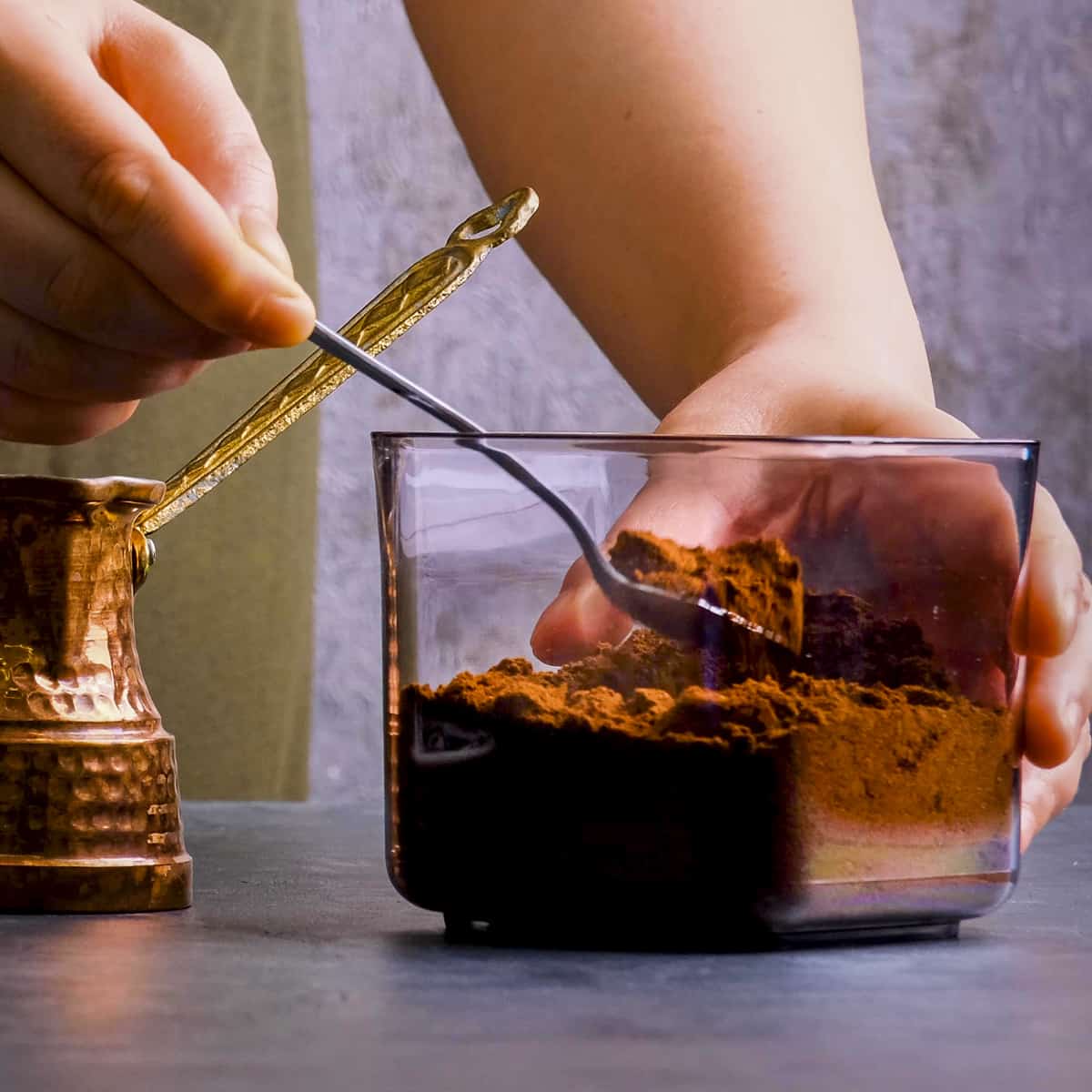
The term Turkish coffee refers to its special brewing method. And the coffee itself (before brewing) doesn't look like your regular coffee beans. It is so finely ground that you might think it is cocoa powder when you first see it.
The ground coffee is combined with water and sugar (optional) in a special coffee pot called cezve or ibrik. They are the ideal pots to make this authentic coffee.
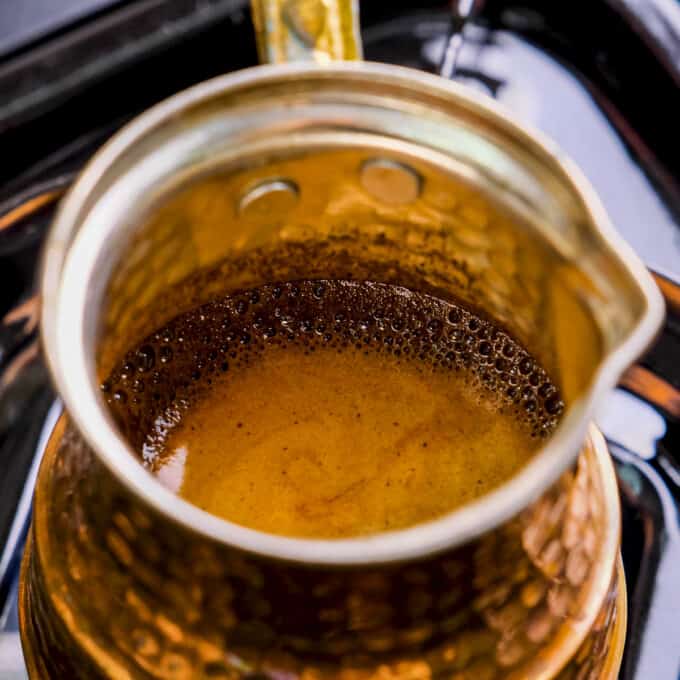
These are small copper pots with a long handle, but stainless steel, ceramic, brass or even glass pots are also common today. They have different sizes. The smallest is for one serving and the largest could be up to 6 servings.
These pots are small and deep with a wide bottom and narrow neck, which helps coffee to produce a good amount of foam. The coffee is simmered with water in these pots over the lowest heat of the stove or traditionally on hot sand.
You end up with a thick and frothy coffee which has a strong flavor. It is served in traditional Turkish coffee cups with a lot of foams on the top. It is significant to be able to have enough foams, which shows how much you know the art of coffee making.
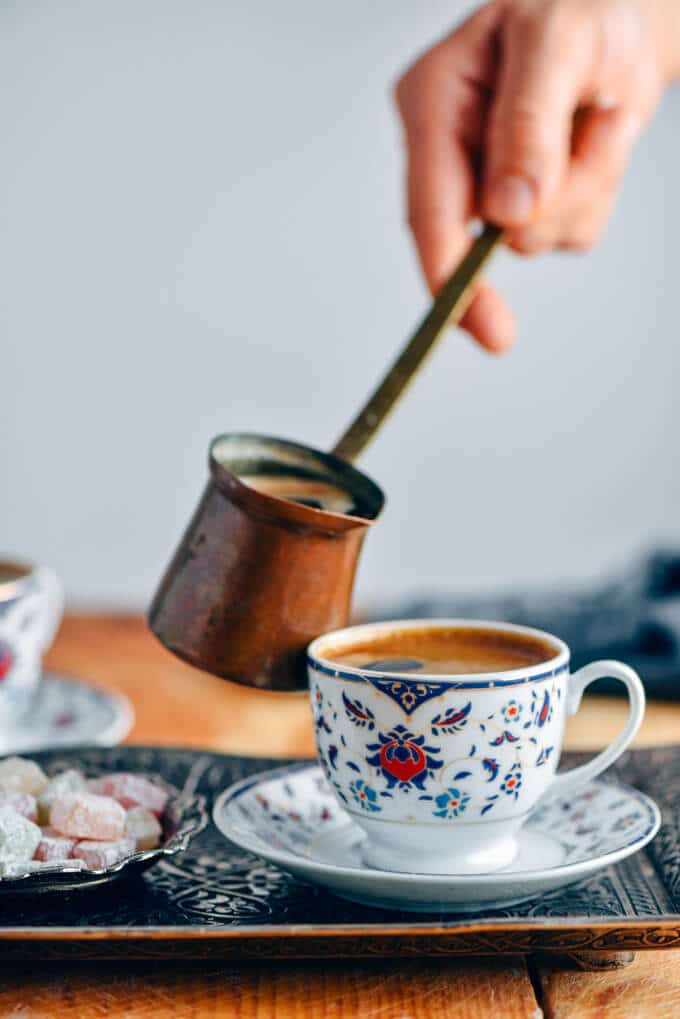
Ingredients
It is a super easy coffee recipe with two or three ingredients. You need:
- Water: It is best to use cold water to have the best foams. Never use warm or hot water.
- Super fine grind coffee: Buy it fresh from a local store if possible. Otherwise, choose the most famous brand from online shops. Don't try to make this coffee with regular ground coffee.
- Sugar: This is optional. It depends on your taste. You can either leave it completely out or add half to 2 cubes of sugar. Please read more about this in the section below.
How to Make It
It is very easy to make Turk kahvesi at home with the following steps:
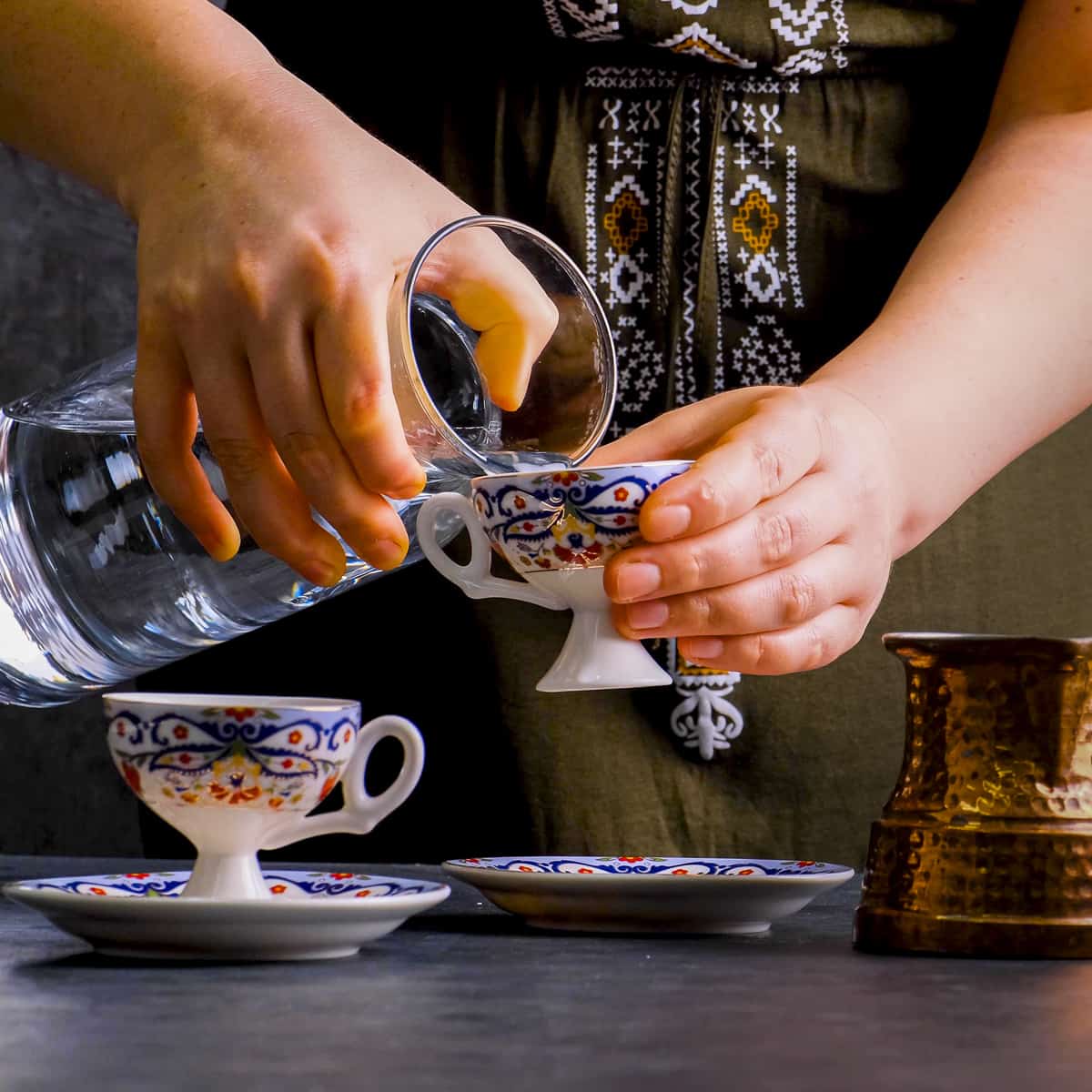
First, measure water with a small coffee cup: Use one small cup of water for one person, two cups for two people and so on. Pour it directly into the small pot cezve.

Second, measure ground coffee: The ratio for a desired consistency is 1:2, which means 1 coffee cup cold water and 2 teaspoons of coffee. Add the ground coffee in the coffee pot.
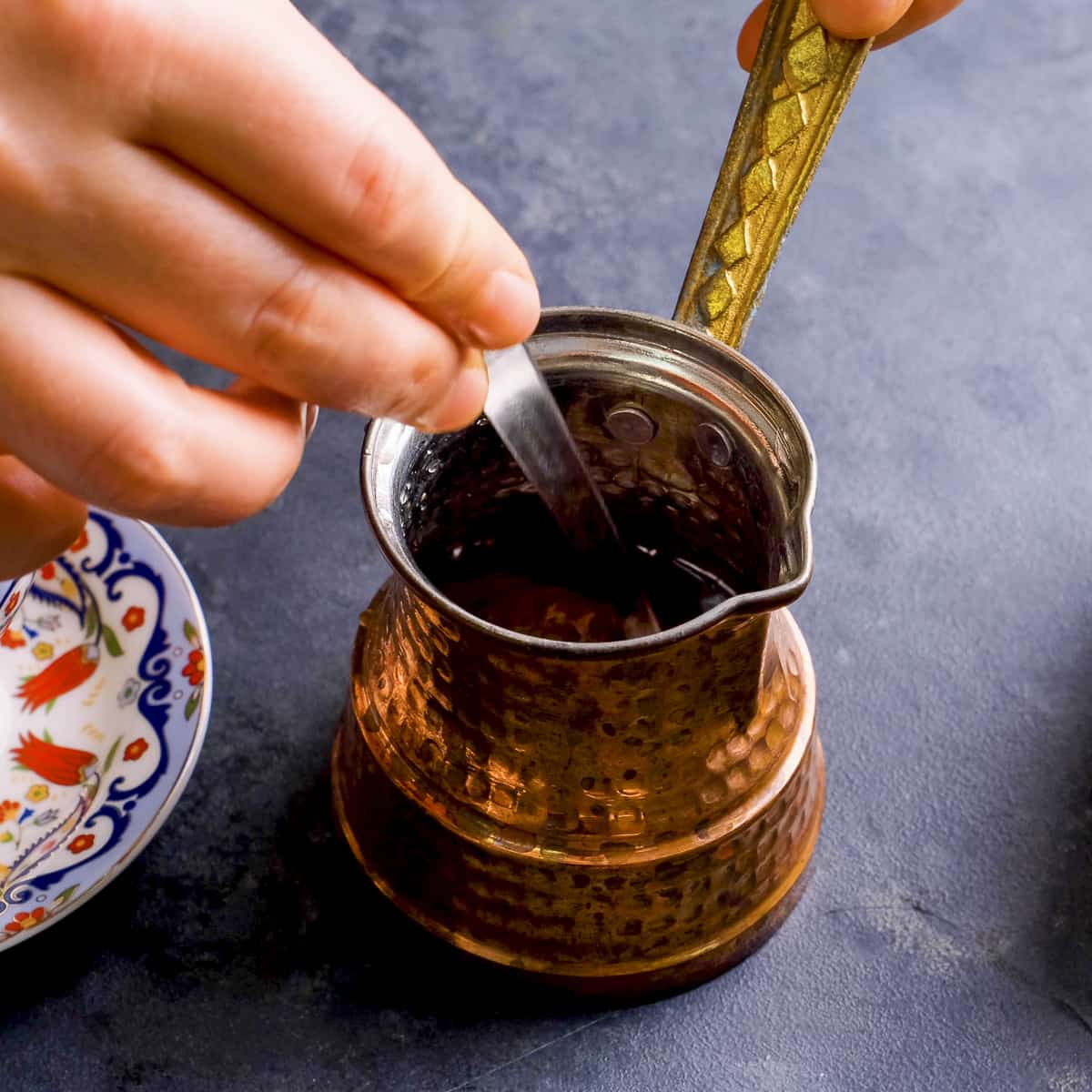
Then, mix coffee and water: Put cold water and finely ground coffee in a Turkish Coffee pot and stir well until combined. If you want your coffee sweet, add sugar along with coffee and water. As a host, you always need to ask your guests how sweet they like their coffee. Possible options are as follows:
- Unsweetened (no sugar added) - Sade
- With little sugar (add ½ cube sugar) - Az sekerli
- A bit sweeter (add 1 cube sugar) - Orta sekerli
- Super sweet (add 2 cubes sugar) - Sekerli
Note: The measurement here is for one coffee cup. If you are making coffee for more than one person and everyone has different sugar likings, make their coffee separately.
Next, cook the coffee: Place the coffee pot on low heat and let it cook for a while, stirring gently two or three times. When it is right about to boil and foams rise, remove it from the heat.
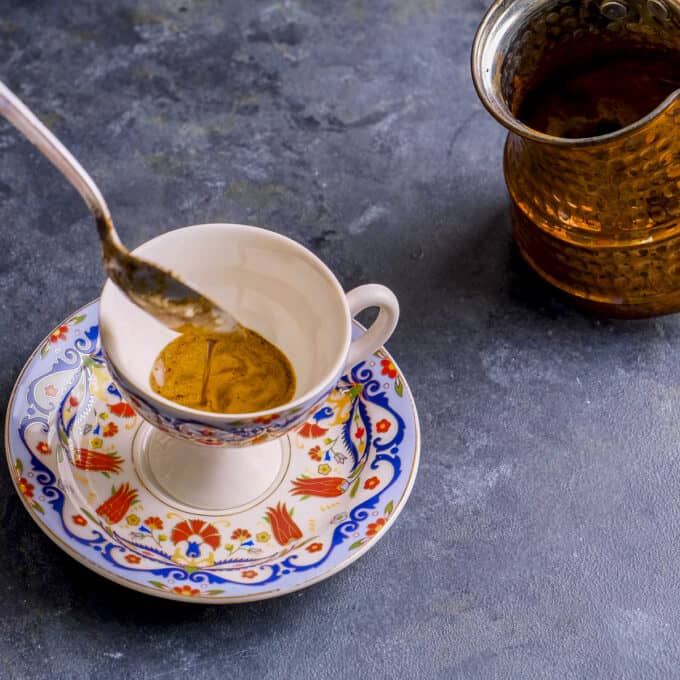
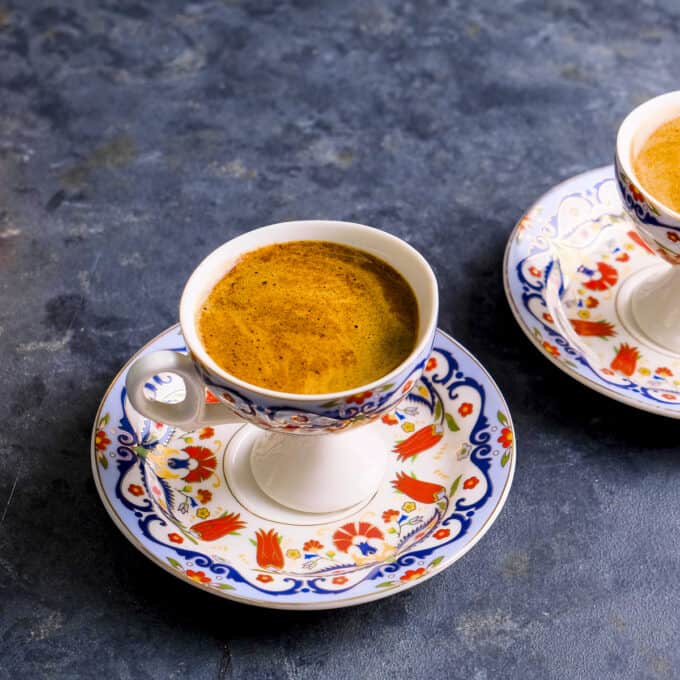
Using a teaspoon, share the foams into each Turkish coffee cup. Put the pot back over medium heat. Let it rise and remove when it starts to boil. Share the coffee into the cups.
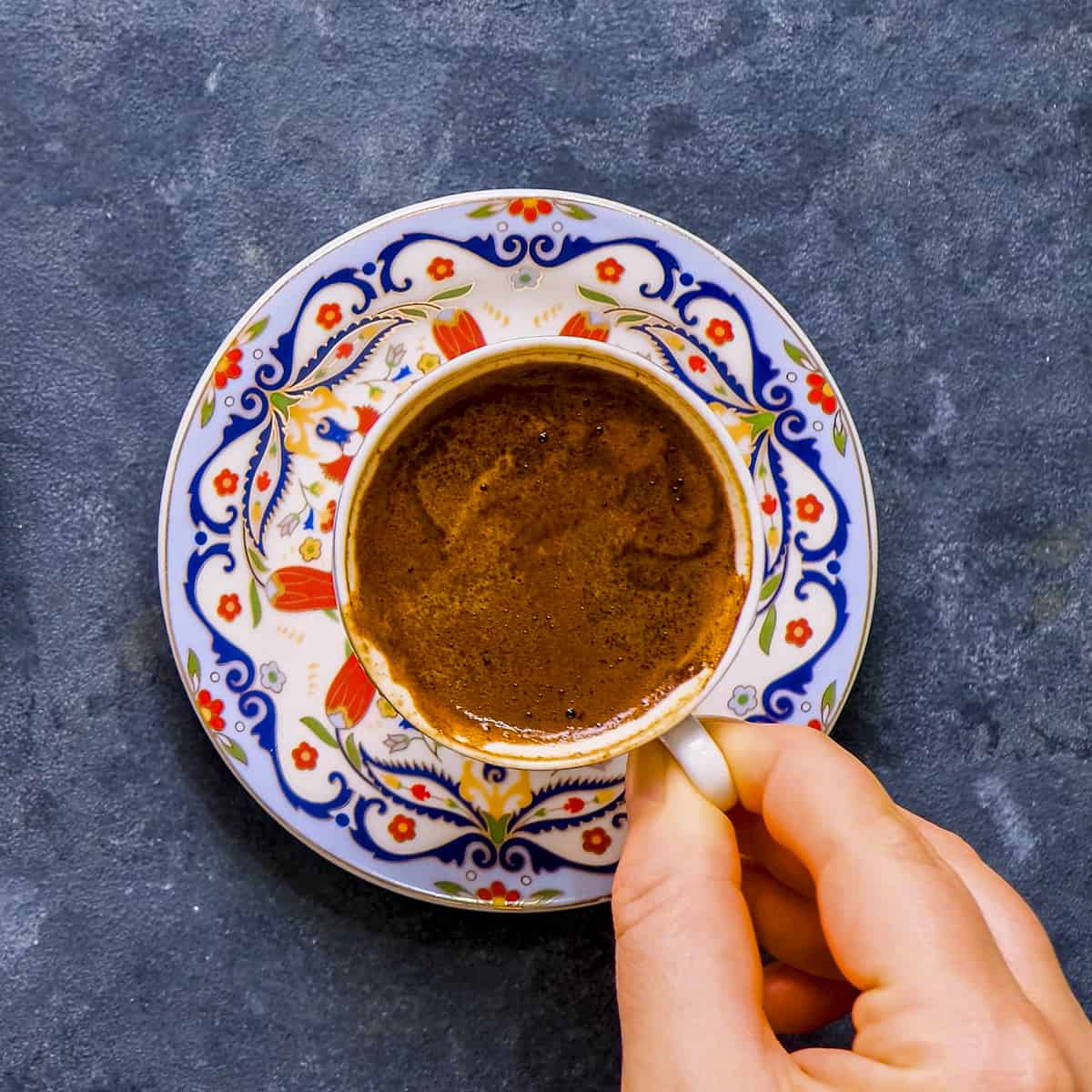
Tips
There are some tips for making your coffee both with enough foams on the top and with the desired consistency:
- Use fresh ground coffee. If your coffee is not fresh and sits in your pantry for months, it doesn’t foam. To keep your coffee fresh after you open the package, store it in an airtight container in the refrigerator.
- Use cold filtered water. Never try to make it with warm or hot water.
- Mix the coffee, water and sugar (if you are using any) in the pot gently until combined. Don’t mix it fast. Always treat your coffee kindly.
- Cook your coffee on the lowest heat, stirring two or three times until it starts to rise. Never let it boil. Remove it right before it boils and share the foams into the cups, using a teaspoon.
- After transferring the foams to the cups and reheating the coffee, pour it slowly into the cups so that the bubbles remain safe.
- If you want more flavor, you can add spices like cardamom or cinnamon in the pot when mixing coffee and water.
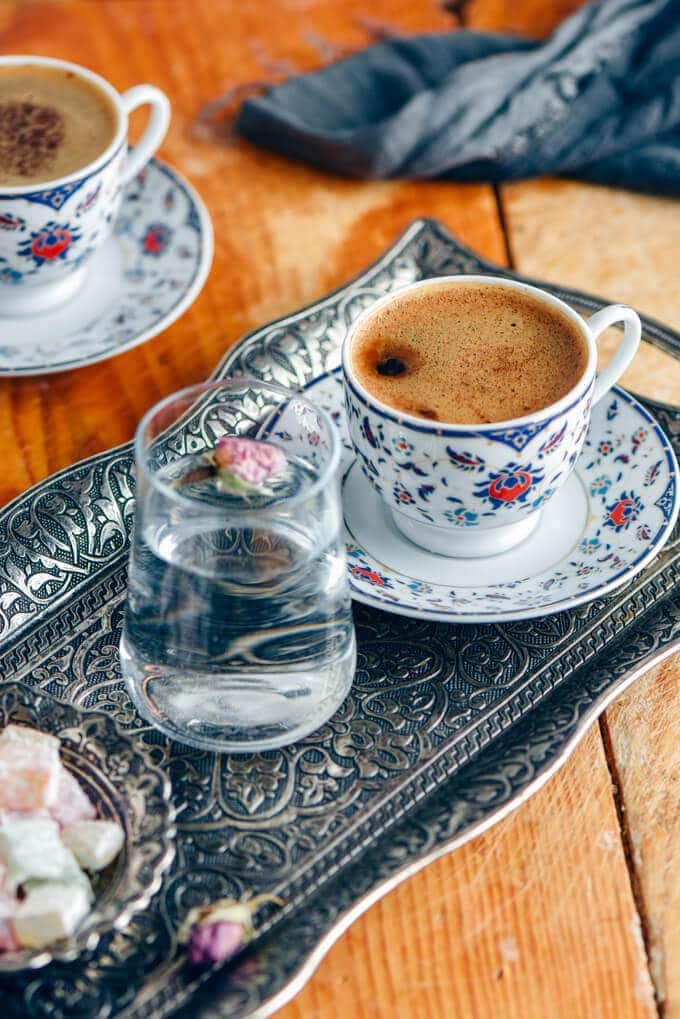
How To Serve It
As for the serving, Turkish coffee has its own traditional way. Cups of Turkish coffee are unique too. They are small cups, known as demitasse cups or kahve fincanı as we say in Turkish. They are like espresso cups.
There is always a glass of cold water on the side. This is to clean your palate before taking your first sip of coffee. So you can feel the flavor of the coffee better.
Also, it is often served with a type of sweet treat like Turkish delight or chocolate on the side. It is even fancier in the culture if you serve it with a traditional dessert like kunafe or baklava.
From grinding to cooking and serving this coffee, it’s like a special ritual. This special drink is a way of socializing for Turkish people. It is mostly enjoyed following a good meal.
How To Buy It
Traditionally, buying coffee from local coffee shops is recommended because Arabica beans are freshly ground in a large coffee grinder in these shops. However, there are still some tips to understand whether it is really fresh and good quality.
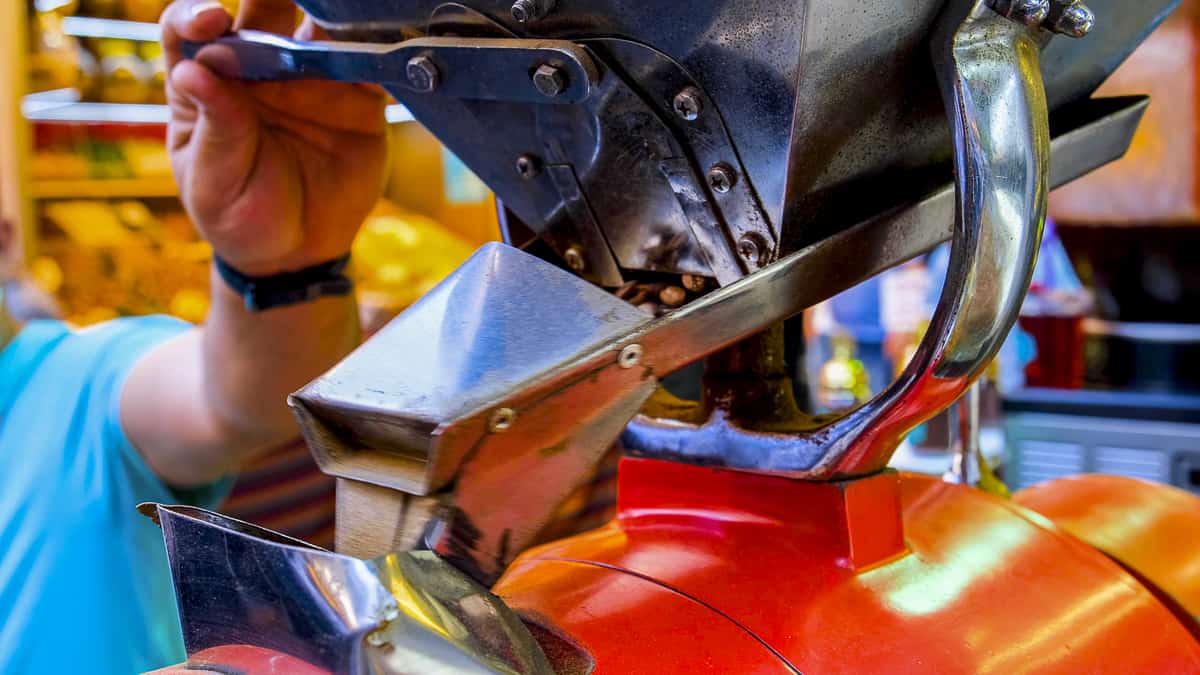
The first thing that is a sign of good quality is the smell of the coffee. If it has a strong smell that makes you feel in heaven, it is a good one. If you can hardly feel the irresistible smell, it is likely to be stale, which will result in a tasteless coffee when you make it.
Another tip to understand how fresh your ground coffee is to get some in your hand and see whether the pieces stick to one another. Fresh coffee never sticks and it is wonderfully crumbly.
Finally, when you are drinking the coffee, you should be feeling that heavenly aroma. If you feel a watery taste, the coffee is not good quality or it is stale.
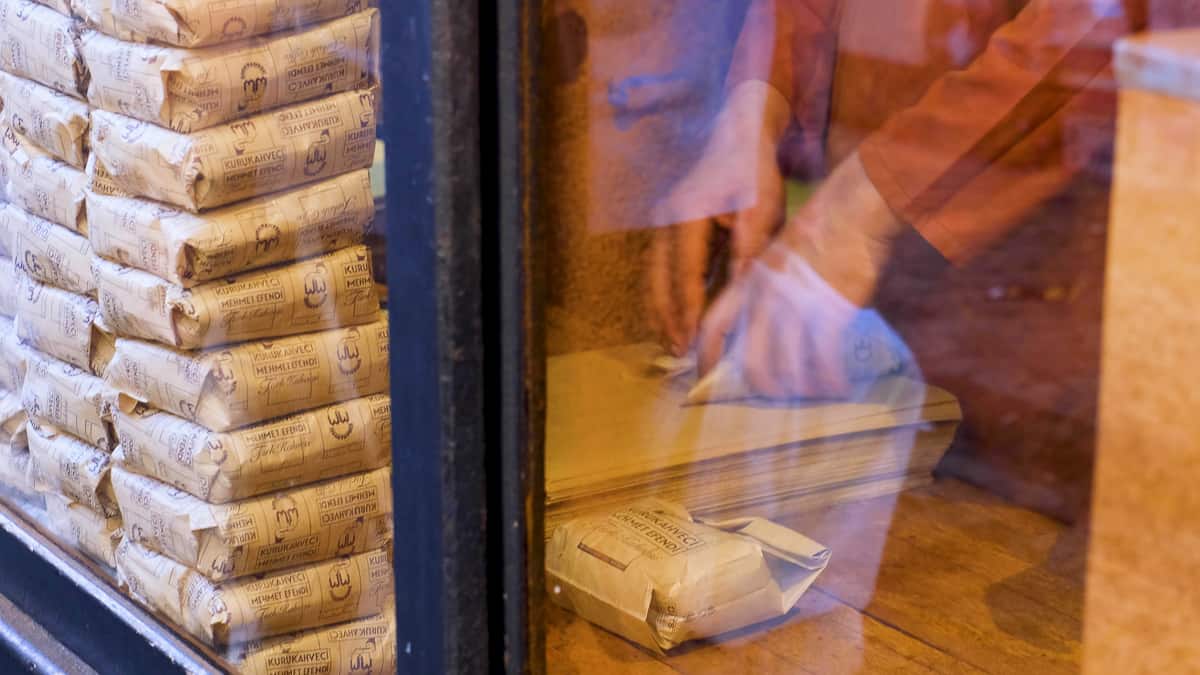
If you are asking for a good Turkish coffee brand, we would suggest KuruKahveci Mehmet Efendi. If you have chance of visiting one of their stores in Turkey, you will see how freshly they grind the coffee beans and then pack the ground coffee with paper wraps.
They are a world famous coffee brand, so you can find them at online shopping markets.
How To Store It
It is important to store ground coffee in the right way so that it keeps its texture and aroma. Tips to keep in mind when storing your coffee:
- Store it in a dry and cool place that is away from sunlight.
- Keep it in an airtight container or in a glass jar with a tight lid.
- Never leave a metal spoon in the container.
- Don't keep it in the opened package. Air causes your ground coffee to get stale fast. Transfer it in an airtight container.

Coffee In Turkish Culture
There are two stories related to coffee. One of them says that coffee brewing was discovered in Yemen, one of the regions in Ottoman Empire in the 16th century. The other says that Syrian traders brought this special coffee brewing method to Istanbul and then it spread to the country from there. And Europe met the Turkish coffee culture in 17th century (source).
There were coffee houses (kahvehane or kıraathane) in Istanbul during the Ottoman Empire. People (mostly men) would meet in these houses to socialize. The sultan prohibited coffee drinking at first due to some religious concerns (source), but then this had to change as a result of large consumption.
These coffeehouses helped this drink to become popular. You can still see coffee houses all around Turkey today and they serve as the meeting place of old men. Thankfully, they are not the only places where you can drink coffee.
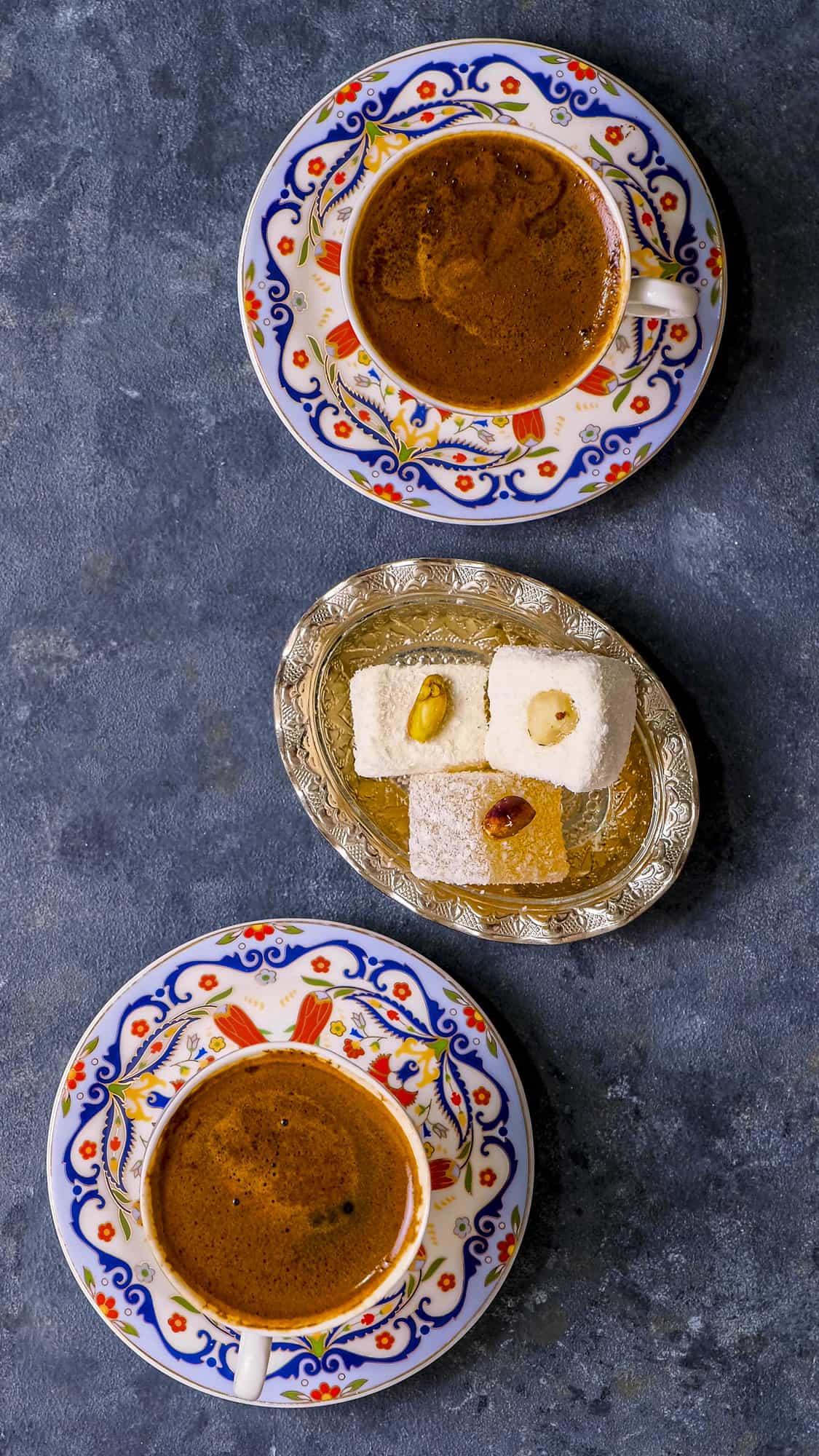
All cafés in the country serve Turkish coffee in their own style. They may even have different types of coffee such as medium roast or lighter roasts, mastic flavored coffee and cardamom flavored coffee aka Ottoman coffee.
Turkish coffee culture has a role even in the marriage customs. A young man's parents visit a young woman's parents to get permission for the marriage of the young couple. During the visit, they expect to be served coffee made by the young woman. And she is supposed to make coffee with as much foam as she can.
Unlike Turkish tea, Turkish coffee is considered as a way of spoiling yourself or your guests. So we offer coffee whenever we have special guests. We serve it hot in small cups with a glass of water on the side.
Fortune Telling (Reading The Cup)
The ceremony doesn’t end even after you finish your coffee. Although it’s not like a rule, most Turkish people love the tradition of coffee reading.
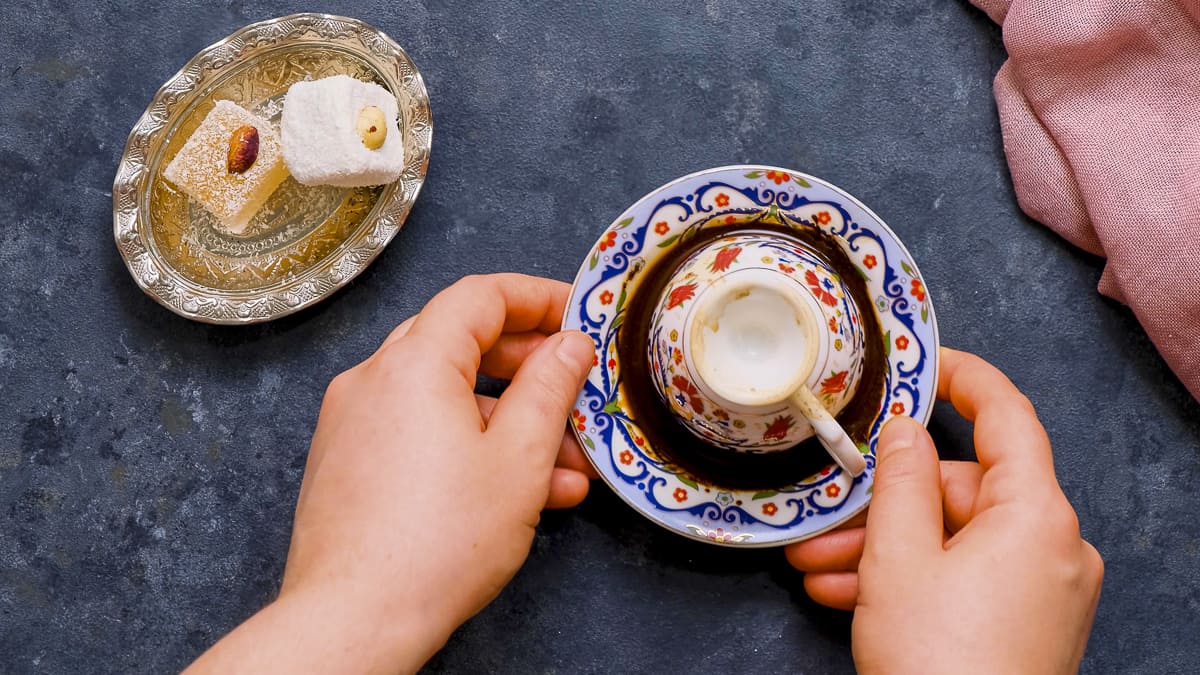
When they finish drinking the coffee, they read the shapes formed by coffee grounds at the bottom of the cup. How? They place the saucer on top of the cup, make their wish and turn it upside down. It is left to cool.
Sometimes a golden ring is placed on the top to make it cool faster. It is ready when the cup is cool enough. Whoever is talented in coffee reading gets the cup carefully and interprets the symbols in the cup.

While most people do this just for fun, there are people who are known as the master of fortune telling. We’ve never tried to read it because the only things we see in the cups are no more than animal shapes. Lol!
FAQs
Don’t worry if you don’t have a traditional cezve or ibrik. A small saucepan works fine as well. The smaller, the better. If you are using a large saucepan and making the coffee for two, you won't have enough foams. On the other hand, if you make it with 6-7 coffee cups of water and enough coffee for this serving, you will manage to get the foams.
If you are after an easier and quicker way, you can definitely look for electrical Turkish coffee makers in the form of a pot online. There are several brands and types with a wide range of prices. Arzum or Fakir are the most popular brands that are used in Turkey.
Traditionally, Turkish coffee is known for its strong aroma, so it’s never made with milk. However, I remember mom would make it with milk for me when I was a kid just like several moms do for kids. So use milk only to give it a mild taste, but don’t expect it to be frothy then.
That is because you need to prepare your palate for the coffee. Traditionally you drink water first and then coffee to feel the maximum aroma of it. You can put a thin slice of apple or rose petal into your water to give it a subtle aroma.
Both of them are strong but Turkish coffee is more condensed and this might cause it to taste more bitter.
No, we don’t drink that sludge. We use that layer for coffee reading aka fortune telling.

More Turkish Drinks
More Turkish Recipes
As always: If you make this recipe, let us know what you think by rating it and leaving a comment below. And post a pic on Instagram too—tag @give_recipe so we can see!
Sign up for the FREE GiveRecipe Newsletter to get the new recipes into your inbox! And stay in touch with us on Facebook, Pinterest, YouTube and Instagram for all the latest updates.
📖 Recipe
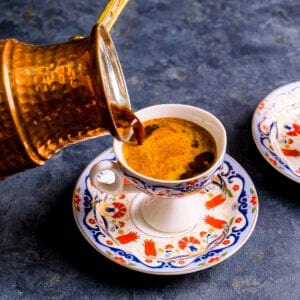
How To Make Turkish Coffee (Turk Kahvesi)
INGREDIENTS
- ½ cup water
- 4 teaspoons Turkish coffee
- 1 cube sugar see the note below
INSTRUCTIONS
- Measure water with a small coffee cup. Use one small cup of water for one person, two cups for two people. Pour it directly into a small pot called cezve.
- Measure ground coffee: The ratio for a desired consistency is 1:2, which means 1 coffee cup cold water and 2 teaspoons ground coffee. Add the ground coffee in the coffee pot.
- Mix coffee and water: Using a teaspoon, mix your finely ground coffee with cold water in a Turkish Coffee pot, gently until well combined. If you want your coffee sweet, add sugar along with coffee and water. (See the notes about sugar).
- Place the coffee pot on low heat and let it cook for a while, stirring gently a few times. When it is right about to boil and foams rise, remove it from the heat. Using a teaspoon, share the foams into each Turkish coffee cup.
- Put the pot back over medium heat. Let it rise and remove when it starts to boil. Share the coffee into the cups.
Video
NOTES
- You always need to ask your guests how sweet they like their coffee. Possible options are as follows: Unsweetened (no sugar added), with little sugar (add ½ cube sugar), a bit sweeter (add 1 cube sugar) and super sweet (add 2 cubes sugar). The sugar measurement here is for one coffee cup. If you are making coffee for more than one person and everyone has different sugar likings, make their coffee separately.
- Use cold filtered water. Never try to make it with warm or hot water.
- Mix the coffee, water and sugar (if you are using any) in the pot gently until combined. Don’t mix it fast. Always treat your coffee kindly.
- Cook your coffee on the lowest heat, stirring two or three times until it starts to rise. Never let it boil. Remove it right before it boils and share the foams into the cups, using a teaspoon.
- After transferring the foams to the cups and reheating the coffee, pour it slowly into the cups so that the bubbles remain safe.
- Don’t worry if you don’t have a traditional cezve or ibrik. A small saucepan works fine as well. The smaller, the better. If you are using a large saucepan and making the coffee for two, you won't have enough foams. On the other hand, if you make it with 6-7 coffee cups of water and enough coffee for this serving, you will manage to get the foams. If you are after an easier and quicker way, you can definitely look for electrical Turkish coffee makers in the form of a pot online.
NUTRITION
Nutrition information is automatically calculated, so should only be used as an approximation.


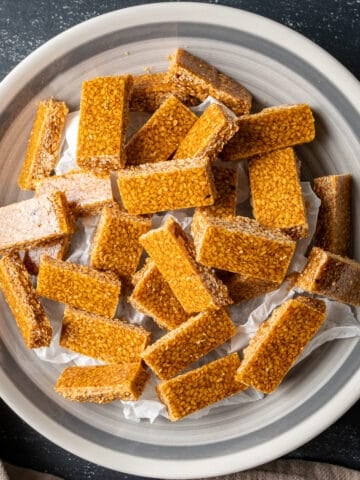
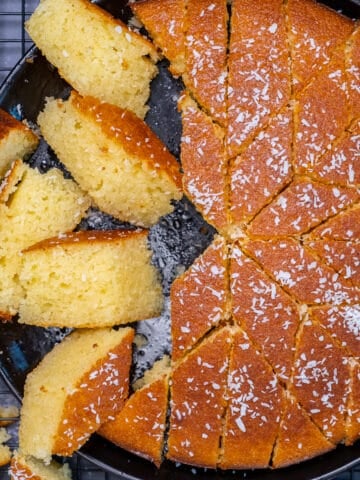
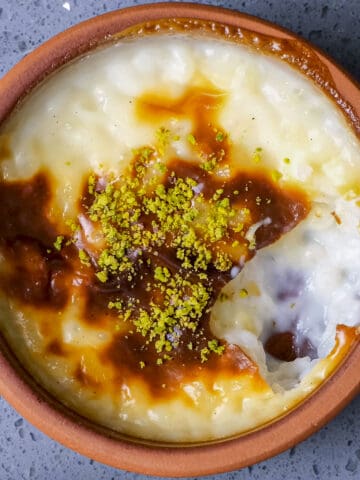
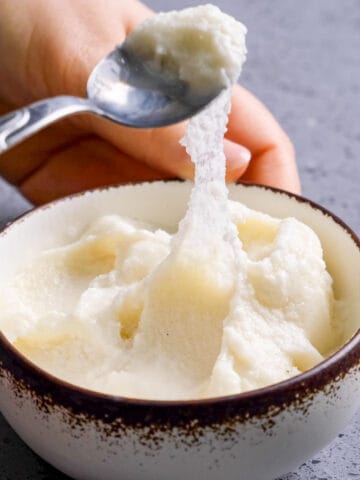
Joyce says
I didn't get foam? What did I do wrong?
Zerrin & Yusuf says
Hi Joyce,
What did you use to cook the coffee in? If you don't use a Turkish coffee pot, getting foams might be a bit challenging.
You need to use a very small and deep saucepan instead. Hope this helps.
Esma says
As a coffee lover, i absolutely liked your recipe. Thanks for your lovely recipes 💕💕💕
Zerrin & Yusuf says
Hi Esma,
You are most welcome. So happy to hear that you are enjoying our recipes.
Hugs from UK canım:)
Zerrin
Roshin says
I'm an Indian living in the gulf, and I've tasted it in restaurants
. Wanted to check an authentic recipe and the tradition before making it. I've just got some powder and I have an ibrik. Can I add milk?
Zerrin & Yusuf says
Hi Roshin,
Traditionally, milk is not used in Turkish coffee. It is only used to make it kid-friendly. Milk is substituted for water in that case.
Selden Deemer says
I have two comments:
1. As the authors write, drink the water first; drinking the water after the coffee could be interpreted as a slight to the host.
2. Re milk, earlier this year I stumbled on a related — but very different — beverage, dibek kahvesi. This is a mixture of arabica coffee, salep (a flour made from the ground root of a type of orchid), gum mastic, chocolate, carob, cream, and cardamom, among other ingredients. Dibek kahvesi smells like hot chocolate, and seems to be most popular in the southeastern part of Anatolia.
I would call dibek kahvesi an "acquired taste" which I have not acquired, but a small amount (no more than 1 tablespoon in a half pound of traditional Turkish coffee) adds an interesting flavor note.
Zerrin & Yusuf says
Hi Selden, thank you so much for your sharing these with us!
Well, we didn't know that drinking the water after coffee is a sign of slight. What we know is about when to drink (before the coffee) but had no idea about when not to drink water. A very interesting tradition.
Also, thanks for reminding us of Dibek kahvesi. I guess it is also called Ottoman coffee, Osmanli kahvesi. Much creamier than regular Turkish coffee, so probably a more appealing alternative for those who are not fan of strong taste of Turkish coffee.
Selden Deemer says
Rica ederim.
I bought a can of "1453 Dibek Kahvesi" last spring, thinking it was just a brand I hadn't seen before. I was very surprised at the chocolate aroma when I opened it, and then I looked at the ingredients. Kurukahveci Mehmet Efendi is the easiest brand to find where I live, and is available from Amazon.
Zerrin & Yusuf says
Hi Selden,
Haven't heard of that brand for dibek kahvesi before. Have to check the online Turkish markets here in UK. Although we love classic Turkish coffee, it is sometimes a good change to have an aromatic coffee. Cheers!
Stephanie says
Thank you for this recipe! I have loved Turkish Coffee ever since I first had some, so my coworker gave me some the other day, but I don’t have am ibrik yet, so I needed to learn how to use a saucepan to make it.
Yusuf says
Hi Stephanie, ibrik or cezve is the best but a saucepan works too. Enjoy!
Aubrey says
I think you meant "Arabica" coffee beans (and not "Arabic). Arabica coffee comes from Ethiopia. Very nice recipe and great pics.
Katy says
Love your pictures and the Turkish coffee looks so good, i have only had them once. I will try again. Thank you so much!
Steph K says
Smell spreading in my house !
Kaleb says
I love it! It is not only a good Turkish coffee recipe but also a good share about the Turkish coffee culture. Thank you!
Diya says
I love it! It is not only a good Turkish coffee recipe but also a good share about the Turkish coffee culture. Thank you!
Erika says
I am a huge coffee fan, love your serving tray by the way, thank you for all the tips, I need to enjoy some Turkish coffee soon!
ROBYN says
Love Turkish coffee. Thanks!